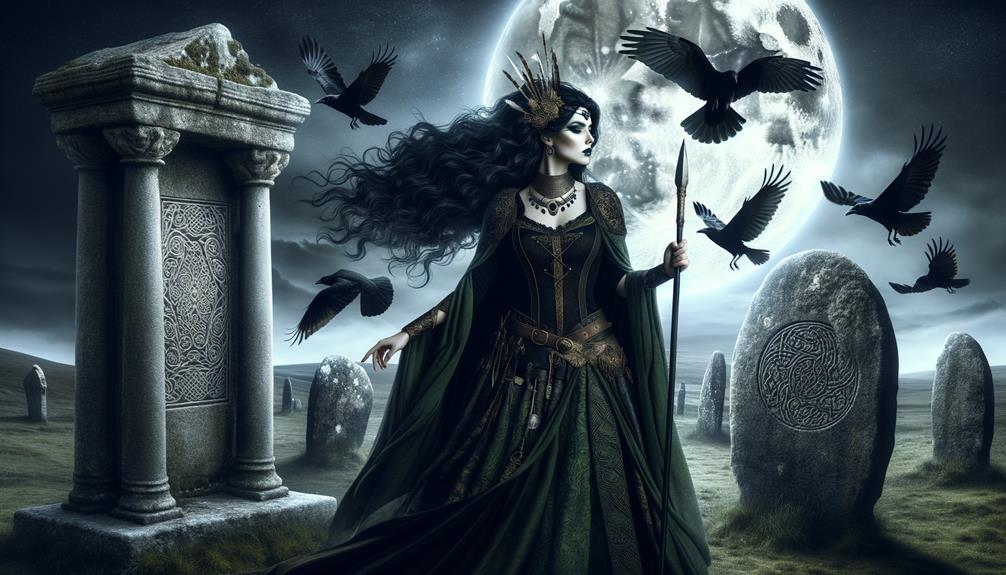When you delve into the study of the Morrigan, you'll meet a Celtic war goddess with a depth and complexity that's truly astounding. She's a three-in-one deal with Badb, Macha, and Nemain, each portraying a distinct aspect of her – life, warfare, and chaos. The crow, her symbol, is a stark omen of imminent death and a testament to her devastating power. Known as the Phantom Queen, her ghostly persona has left an indelible mark on Celtic culture, infusing it with a deep respect for the mystical. Her ability to shape-shift and her love for the frenzy of battle underscore her potent role in myth. To fully grasp her position in Celtic lore, we need to dig deeper into these fascinating traits.
The Triple Identity of Morrígan
If we take a closer look at the captivating character of Morrígan, a Celtic goddess of war, we run into a rather fascinating aspect of her persona – her triple identity. Known as The Three Morrgna, this trio includes Badb, Macha, and Nemain, each of whom symbolizes different elements of power and sway in Celtic myths. Badb, described as the Crow of Battle, is closely linked with war and the finality of death. She's known to make an appearance during times of strife, providing predictions or even swaying the tide of the war.
Then there's Macha, who brings a softer touch to Morrígan's identity. She stands for fertility, motherhood, and the miracle of childbirth. Finally, we have Nemain, who embodies the chaos and confusion that's often witnessed amidst the madness of a battlefield.
This triple identity, unique to Morrígan, perfectly illustrates her multifaceted character. She's an embodiment of life, death, and everything chaotic in between – a testament to her immense power and influence in the stories of Celtic mythology.
Symbols and Representations
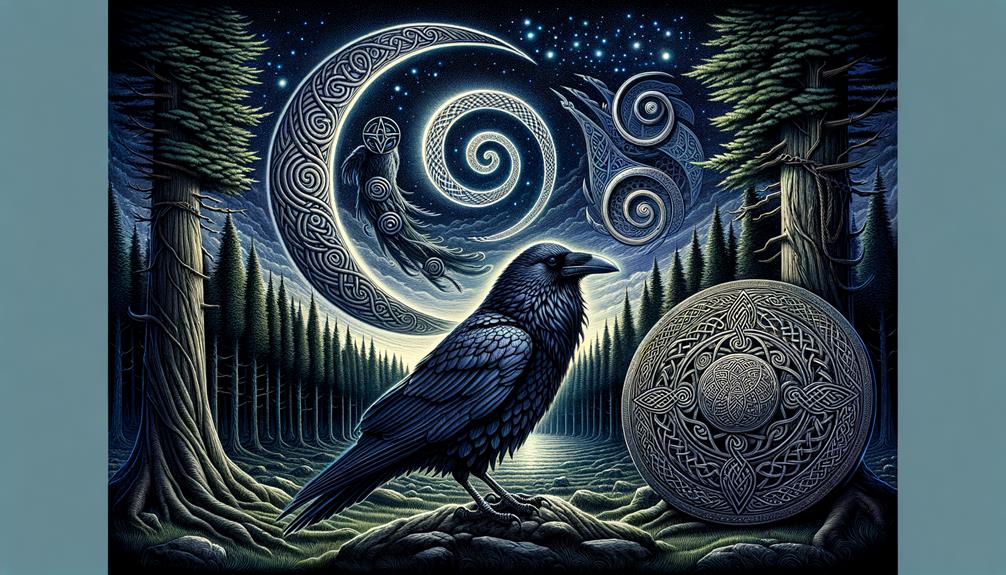
Taking a closer look at Morrígan, there's more to her than just her triple identity. Her ties with the crow or raven reveal her deep links with war, death, and discord. Often seen on Irish battlefields according to folklore, this bird is more than just a symbol—it's a physical embodiment of Morrigan, cementing her status as the War Goddess. Plus, her ability to transform into this bird not only shows her supernatural abilities but also highlights her three-fold nature, a typical feature in Celtic myths. This trio—Morrígan, Badb, and Macha—represent a powerful force. Also, her other name, the Phantom Queen, reflects her mysterious and intimidating character. Through these symbols and representations, we get a sense of Morrigan's intricate and layered personality.
Morrígan in Celtic Society
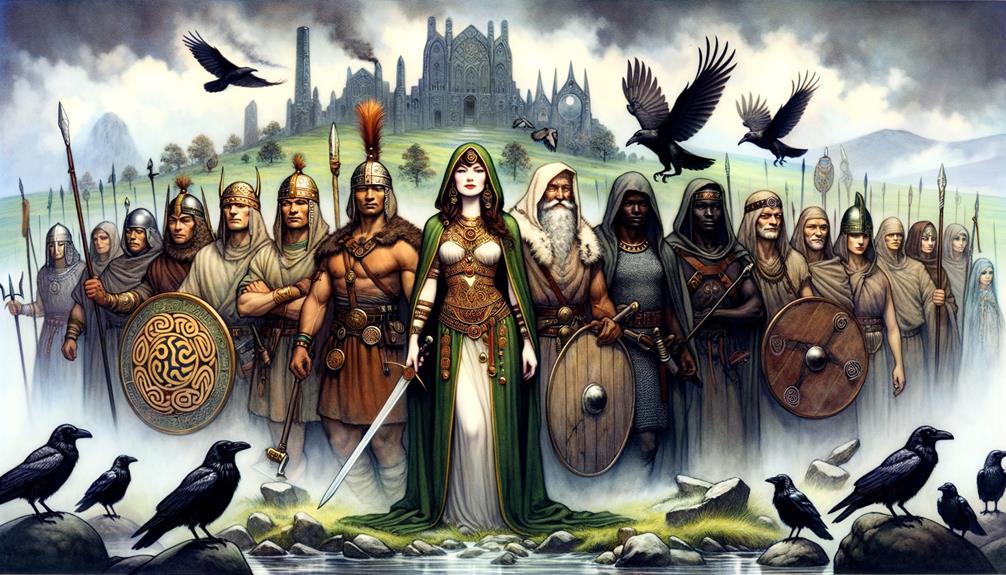
Let's chat about Morrígan's role in Celtic society. This influential war goddess was not only feared but also deeply respected – a testament to the high regard for supernatural forces within the culture. Her role was tied to the idea of war, and her influence was felt throughout society.
- Celtic warriors often invoked Morrígan's name before a battle, hoping for her protection and a victorious outcome. It highlights the considerable weight they put on the spiritual aspect of their culture.
- Regular rituals and offerings were made to Morrígan, especially during turbulent times. It was a way to seek her guidance and navigate through the rough patches.
- Morrígan's significant position in Celtic society illuminates the importance they placed on warfare and the supernatural, key components of their cultural identity.
The high esteem for Morrígan mirrors the prevailing values and beliefs in Celtic society. In a nutshell, Celtic society's fabric was profoundly influenced by the supernatural elements, and Morrígan was at the heart of it.
Morrígans Role in Mythology
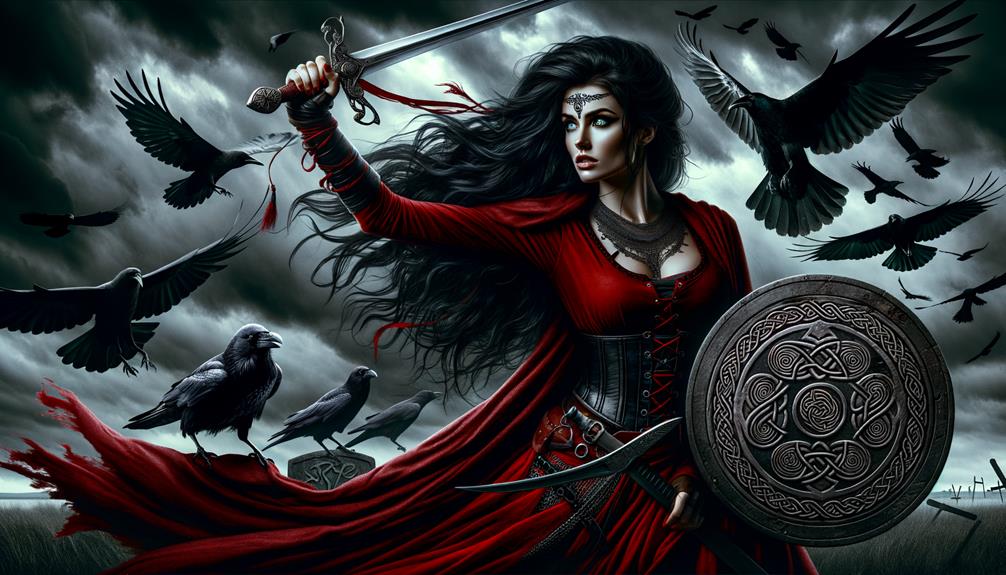
Let's chat about Morrígan, the fierce queen and goddess from Irish mythology who's known for her extraordinary ability to incite war and instigate a ferocious battle frenzy. She's no background character; she takes centre stage as one of the primary war goddesses. Along with Badb and Macha, Morrígan forms the power trio known as the Morrígna.
Morrígan is not just a **goddess of war; she's also a master of disguise, often shape-shifting into a crow** on the battlefield. Her appearance as a crow is a chilling sign that death is near, which gives you a sense of her powerful influence.
Another intriguing facet of Morrígan's character is her ability to foresee future events, which adds a dash of enigma to her persona. One of her most infamous deeds was causing the downfall of the hero-warrior Cú Chulainn, further establishing her as the terrifying Celtic Goddess of War.
Legacy of Morrígan
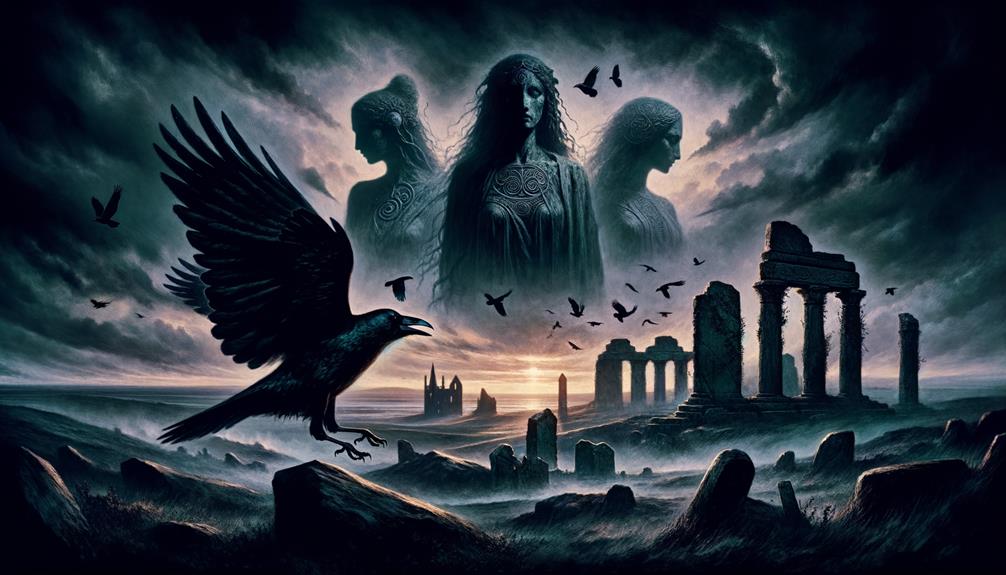
When we talk about Morrígan, we're talking about a truly multifaceted deity deeply entwined with Irish mythology. This Celtic Goddess, known for her transformative abilities, is often shown as a crow or raven, signifying her link to death.
- She forms part of the Three Morrgna—Badb, Macha, and Nemain—each one reflecting different traits of her persona.
- Her connections with the Dagda and the Tuatha De Danann are key to grasping her role.
- Her encounters with C Chulainn have a central part in various myths.
But the influence of Morrígan doesn't stop with the ancient world. It continues into today's folklore and literature, inspiring characters like the Banshee and Morgan le Fay. As such, Morrígan remains an intriguing figure, deftly juggling the grim concepts of death and war with the unstoppable force of destiny.
Frequently Asked Questions
Who Is the Morrigan War Goddess?
The Morrigan, huh? Now that's a name that rings a bell. If you're into Irish mythology, you'd probably know her as this formidable character associated with war and destiny. What's super intriguing about her is her ability to morph into various forms – think crow, raven, eel or even a wolf!
Who Is the Female God of War in Celtic Mythology?
Did you know that there's a female god of war in Celtic mythology? She's a fascinating character with an array of powers, including the ability to shape-shift. Not only that, she's also linked with themes of death and destiny. She's a fierce warrior goddess and is part of a group known as the Morrígna trio. She even goes by several titles, one of the most intriguing being The Phantom Queen.
Who Is the Triple Goddess of War?
The Triple Goddess of War is really an intriguing idea. The figures Badb, Macha, and Nemain represent this. Each stands for a unique aspect of war – death, fertility, and chaos. In Celtic mythology, they give us a sense of the multifaceted nature of war.
Who Is the Celtic Queen of the Dead?
Do you know who holds the title of the queen of the dead in Celtic mythology? It's actually a deity named Morrigan. She's quite a complex character, often linked to war, death, and what's destined to happen. She's often shown as a warrior, which fits her fierce nature, and she's also known for her ability to change her form, regularly into a crow or a raven.

